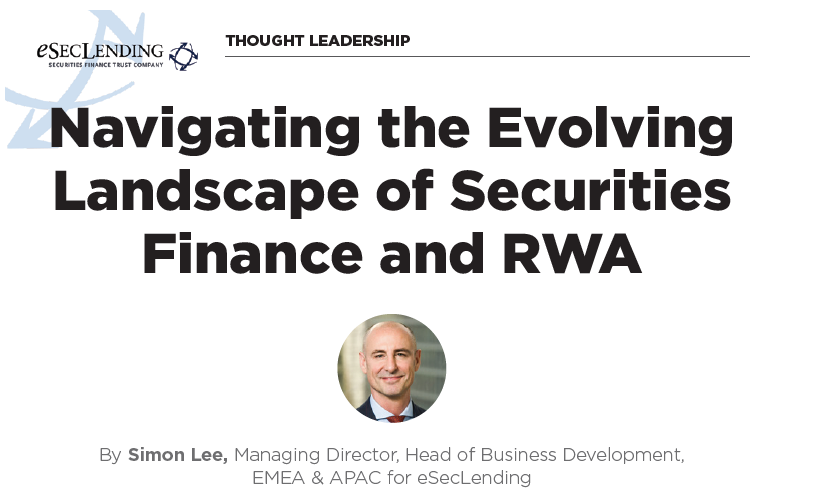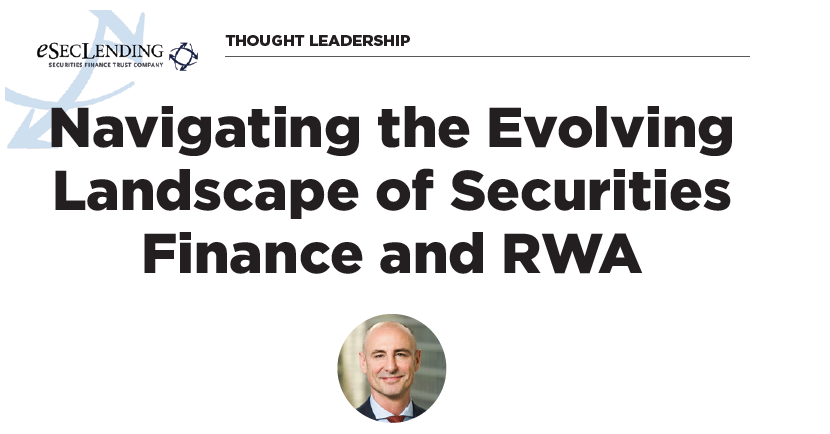eSeclending's Simon Lee on Navigating the Evolving Landscape of Securities Finance and RWA

By Simon Lee, Managing Director, Head of Business Development, EMEA & APAC for eSecLending
This article is part of the 2023 Autumn Magazine, which can be accessed here.
With the IMN Beneficial Owner Conference in London and the ISLA Conference in Lisbon recently behind us, it seems an appropriate time to take a moment to reflect on the key theme affecting our industry at present, that of the increasing cost of risk-weightedasset (RWA) affecting all market participants. Given the dynamic nature of the subject and the everevolving adaptations of the impacted parties, it is increasingly important for organisations to stay on top of these current challenges as well as consider what may come to pass in 2024 and beyond.
Top of the agenda remains counterparty indemnification, which we expect to continue to be the case for the next few years. Many column inches have been devoted, hours of podcasts broadcast, and conference panels dedicated to the topic, indicative of the importance market participants place on indemnification, which has been a cornerstone of the securities lending risk management framework for decades.
To boil down the subject in simple terms; due to the regulatory requirement for banks to allocate more capital to support counterparty indemnification, combined with a general increase in the value of capital, these indemnities now inflict a material cost to the securities lending programmes managed by custody banks. In order to maintain profitability and to offset these costs, banks have a variety of options available to them, all of which can negatively impact the performance of asset owners that participate in those lending programmes.
These changes, as well as the impact they may have on programme participants, are summarised thus.
• Modified trading strategies that focus on transactions that are most capital efficient for the bank.
- Reduces revenue for client, lowers performance, bifurcates alignment of interest between agent bank and asset owner.
• Higher bank fees via adjusted fee split.
- Reduced revenue, reduced performance, increased agent costs borne by asset owner.
• Reduce or limit counterparty indemnification.
- Transfers counterparty default risk to asset owner.
As this storyline continues to play out it is likely that beneficial owners that lend via an agent will take one of two paths in the short to medium term, either acknowledging and accepting this new paradigm, or implementing measures to counter the hit on performance such as expanding eligible collateral schedules, trading with new counterparties, and accessing alternative routes to market.
As we observe agent lenders reacting to increased RWA costs, so too is the borrower community adapting their practises and trading strategies to improve their profit and loss in this environment. The focus here is on shifting trading volumes into more capital-friendly structures, and in much the same way that beneficial owners can increase revenues by meeting borrower demand to expand collateral schedules, similarly those that can participate in these new trade types may benefit from an increase in trade volume on a relative basis.
Lending under a Pledge collateral structure has seen increased momentum in 2023, which will continue into 2024 and beyond, with an expectation that an increasing number of borrower counterparties will look to transact via pledge as time progresses. Certain categories of beneficial owners may not be able to participate in these trades due to regulatory restrictions, which in and of itself may benefit those that can. Elsewhere, the CCP conversation was brought back to the table in 2023.
Given the challenges the industry previously faced in transacting over this medium it remains to be seen whether things will be different this time around. The cost benefit discussion has of course evolved, amplifying the incentives for interested parties to participate; regardless, the expectation is for a clearer understanding of the landscape through 2024.
Lastly, we note a theme that has been slowly gathering momentum in recent years, and saw a meaningful upturn in 2023, that of beneficial owners – and buy-side firms more generally – engaging directly in securities lending trading activity outside of the agency construct. This is typically manifesting in what are commonly known as peer-to-peer (P2P) transactions, the lending and borrowing of cash and/or securities directly between two beneficial owners.
These transactions facilitate an alternative source of financing, diversifying counterparty exposure, and as the traditional agency route to market meets RWA challenges, can offer better pricing and stability of supply. These transactions bring with them their own operational, legal, and credit challenges, and are subsequently executed selectively, but volumes are expected to increase next year, nonetheless.
Historically the preserve of the very largest asset owners, discussions around self-managed programmes are also expected to become more prevalent in the coming year. As the largest beneficial owners get even larger, as their buying power increases, and as sophisticated trading and benchmarking tools proliferate, more organisations will have both the scale and capabilities to take what have effectively been outsourced securities lending programmes, in-house, either in part or in whole.
This however is not a small undertaking, especially when one considers the resources to manage the operational and risk elements of the business, so to what extent this materialises remains to be seen, but with the impact of RWA costs as discussed here, and an increased focus on counterparty quality, the market may be positively disposed toward a shift of this nature.
While the securities lending marketplace undergoes continuous evolution, there are instances where the rate of change appears to lag behind expectations. Yet, at this juncture, a notable shift is evident, with the influence of rising RWA costs driving change for all market participants. As we approach Q4 and direct our attention to the year’s conclusion, the outlook for 2024 points to examples of material change being more likely than not.
Found this useful?
Take a complimentary trial of the FOW Marketing Intelligence Platform – the comprehensive source of news and analysis across the buy- and sell- side.
Gain access to:
- A single source of in-depth news, insight and analysis across Asset Management, Securities Finance, Custody, Fund Services and Derivatives
- Our interactive database, optimized to enable you to summarise data and build graphs outlining market activity
- Exclusive whitepapers, supplements and industry analysis curated and published by Futures & Options World
- Breaking news, daily and weekly alerts on the markets most relevant to you




